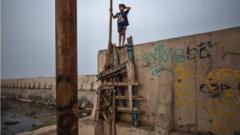In 2009, the commitment made by wealthier nations to provide $100 billion annually to developing countries for climate action by 2020 remains a contentious issue as COP29 approaches. Despite this pledge, global temperatures have risen, and emissions have increased, increasing the need for substantial investments in climate change solutions.
At the climate summit in Baku, Azerbaijan, countries will negotiate new financial targets while addressing how much aid will be allocated, the identities of contributing nations, and the strategic utilization of funds. Climate financing efforts are typically categorized into three main areas: loss and damage, mitigation, and adaptation.
The loss and damage fund, established at COP27, aims to assist developing nations already facing severe climate impacts. With recent events like flooding in Myanmar and droughts in East Africa, the urgency for dedicated financial resources has heightened. Meanwhile, mitigation focuses on helping developing countries phase out fossil fuel reliance—an area where investments tend to be profitable. Adaptation financing, distinct from loss and damage, emphasizes preparatory measures for anticipated climate challenges, including infrastructural improvements to withstand flooding or climate-resilient crops.
Initially, the deadline for the $100 billion commitment was set for 2020, but only $83.3 billion was reported by then. Although the goal was met in 2023, it is evident that the overall financing required is vastly larger than current contributions, with some estimates suggesting that developing nations may need up to $6.9 trillion by 2030 just to mitigate climate impacts effectively.
At COP29, negotiations on new funding goals are multifaceted; developing nations like those aligned with the G77 + China coalition have stated that a minimum of $1.3 trillion is necessary. However, wealthier nations worry that ongoing economic challenges will prevent them from meeting existing commitments. Furthermore, the method of financial support remains a contentious topic, as substantial funding is still delivered as loans rather than grants, which raises concerns about increasing debt burdens in vulnerable nations.
As climate change catalyzes extreme weather events globally, the dialogue at COP29 will determine not only financial targets but also the approach to responsibility-sharing among nations, especially regarding emerging economies like China, which now have higher greenhouse gas emissions. The outcome of these discussions holds critical implications for the future of international climate finance and action against climate impacts.
At the climate summit in Baku, Azerbaijan, countries will negotiate new financial targets while addressing how much aid will be allocated, the identities of contributing nations, and the strategic utilization of funds. Climate financing efforts are typically categorized into three main areas: loss and damage, mitigation, and adaptation.
The loss and damage fund, established at COP27, aims to assist developing nations already facing severe climate impacts. With recent events like flooding in Myanmar and droughts in East Africa, the urgency for dedicated financial resources has heightened. Meanwhile, mitigation focuses on helping developing countries phase out fossil fuel reliance—an area where investments tend to be profitable. Adaptation financing, distinct from loss and damage, emphasizes preparatory measures for anticipated climate challenges, including infrastructural improvements to withstand flooding or climate-resilient crops.
Initially, the deadline for the $100 billion commitment was set for 2020, but only $83.3 billion was reported by then. Although the goal was met in 2023, it is evident that the overall financing required is vastly larger than current contributions, with some estimates suggesting that developing nations may need up to $6.9 trillion by 2030 just to mitigate climate impacts effectively.
At COP29, negotiations on new funding goals are multifaceted; developing nations like those aligned with the G77 + China coalition have stated that a minimum of $1.3 trillion is necessary. However, wealthier nations worry that ongoing economic challenges will prevent them from meeting existing commitments. Furthermore, the method of financial support remains a contentious topic, as substantial funding is still delivered as loans rather than grants, which raises concerns about increasing debt burdens in vulnerable nations.
As climate change catalyzes extreme weather events globally, the dialogue at COP29 will determine not only financial targets but also the approach to responsibility-sharing among nations, especially regarding emerging economies like China, which now have higher greenhouse gas emissions. The outcome of these discussions holds critical implications for the future of international climate finance and action against climate impacts.



















